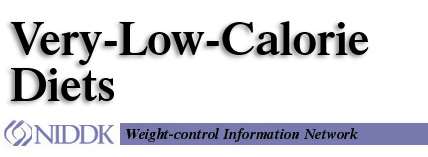 |

The
konjac foods - The very low calorie diets
|
|
|


|
Obesity affects nearly one-third of adults in the United States,
increasing their risk for diabetes, high blood pressure, and heart
disease. Traditional weight loss methods include low-calorie diets
from 800 to 1,500 calories a day and regular physical activity.
Health care providers sometimes consider an alternative method
for bringing about significant short-term weight loss in patients
who are moderately to extremely obese: the very-low-calorie diet.
Top
|
|
|
VLCDs are commercially prepared formulas of about 800 calories that
replace all usual food intake for several weeks or months. VLCDs
are not the same as over-the-counter meal replacements, which
are meant to substitute for one or two meals a day. VLCDs, when
used under proper medical supervision, effectively produce significant
short-term weight loss in patients who are moderately to extremely
obese.
Studies have shown that meal replacements at higher calorie levels
(800 ĘC 1000 calories) produce weight loss similar to that seen
with much lower calorie levels, probably due to better compliance
with the diet. In addition, VLCDs are usually part of weight-loss
treatment programs that include other techniques such as behavioral
therapy, nutrition counseling, physical activity, and/or drug
treatment.
Top
|
|
|
|
VLCDs
are intended to produce rapid weight loss at the start of a
weight-loss program in patients with a body mass index (BMI)
greater than 30. BMI correlates significantly with total body
fat content. It is calculated by dividing weight in kilograms
by height in meters squared, or by dividing weight in pounds
by height in inches squared and multiplying by 703.
Use
of VLCDs in patients with a BMI of 27 to 30 should be reserved
for those who have medical complications resulting from their
overweight. VLCDs are not recommended for pregnant or breastfeeding
women. VLCDs are not appropriate for children or adolescents,
except in specialized treatment programs.
Very
little information exists regarding the use of VLCDs in older
people. Because people over age 50 already experience normal
depletion of lean body mass, use of a VLCD may not be warranted.
Also, people over 50 may not tolerate the side effects associated
with VLCDs because of preexisting medical conditions or need
for other medications. Physicians must evaluate on a case-by-case
basis the potential risks and benefits of rapid weight loss
in older individuals, as well as in people with significant
medical problems or who are on medications.
Top
|
|
Health benefits of a VLCD
|
A
VLCD may allow a patient who is moderately to extremely obese
to lose about 3 to 5 pounds per week, for an average total weight
loss of 44 pounds over 12 weeks. Such a weight loss can rapidly
improve obesity-related medical conditions, including diabetes,
high blood pressure, and high cholesterol.
Top
|
|
Adverse effects of a VLCD
|
Many patients on a VLCD for 4 to 16 weeks report minor side effects
such as fatigue, constipation, nausea, and diarrhea, but these
conditions usually improve within a few weeks and rarely prevent
patients from completing the program. The most common serious
side effect is gallstone formation. Gallstones, which often
develop anyway in people who are obese, especially women, are
even more common during rapid weight loss. Research indicates
that rapid weight loss may increase cholesterol levels in the
gallbladder and decrease its ability to contract and expel bile.
The drug ursodiol can prevent gallstone formation during rapid
weight loss, but is not often used for this purpose.
Top
|
|
Maintaining Weight Loss
|
Studies show that the long-term results of VLCDs vary widely, but
weight regain is common. Combining a VLCD with behavior therapy
and physical activity may help increase weight loss and slow weight
regain. In the long term, however, VLCDs are no more effective
than more modest dietary restrictions.
For most people who are obese, obesity is a long-term condition that
requires a lifetime of attention even after formal weight loss
treatment ends. Therefore, health care providers should encourage
patients who are obese to commit to permanent changes of healthier
eating, regular physical activity, and an improved outlook about
food.
Endnote: This fact sheet is an updated, modified version of
a previously published review article appearing in the August
25, 1993 issue of the Journal of the American Medical Association.
Both the review article and this fact sheet were developed with
the advice of the National Task Force on Prevention and Treatment
of Obesity.
Top
|
|
Additional Reading
|
Dieting
and Gallstones
NIH Publication No. 02-3677. February 2002. Available from WIN.
Active
at Any Size
NIH Publication No. 00-4352. March 2001. Available from WIN.
Healthy
Eating and Physical Activity Across Your Lifespan: Better Health
and You
NIH Publication No. 02-4992. June 2002. Available from WIN.
To request a free brochure, call WIN at 1-877-946-4627 or log on
to www.niddk.nih.gov/health/nutrit/nutrit.htm.
Top
|
|
| |
Weight-control Information Network
1
WIN WAY
BETHESDA, MD 20892-3665
Phone: (202) 828-1025
FAX: (202) 828-1028
Toll-free number: 1-877-946-4627
Internet: www.niddk.nih.gov/health/nutrit/nutrit.htm
E-mail: win@info.niddk.nih.gov
The Weight-control Information Network (WIN) is a service of the
National Institute of Diabetes and Digestive and Kidney Diseases
of the National Institutes of Health, which is the Department
of Health and Human Services' lead agency responsible for biomedical
research on nutrition and obesity. Authorized by Congress (Public
Law 103-43), WIN provides the general public, health professionals,
the media, and Congress with up-to-date, science-based health
information on weight control, obesity, physical activity, and
related nutritional issues.
WIN answers inquiries, develops and distributes publications, and
works closely with professional and patient organizations and
Government agencies to coordinate resources about weight control
and related issues.
Publications produced by WIN are reviewed by both NIDDK scientists
and outside experts. This fact sheet was also reviewed by Rena
Wing, Ph.D., Professor, Brown University and University of Pittsburgh
School of Medicine.
This e-text is not copyrighted. WIN encourages users of this e-pub
to duplicate and distribute as many copies as desired.
Top
|
|


|
U.S. DEPARTMENT OF HEALTH AND HUMAN SERVICES
National Institutes of Health
NIH Publication No. 03-3894
January 2003
e-text posted: March 2003
|
|
 |
|
 |
|